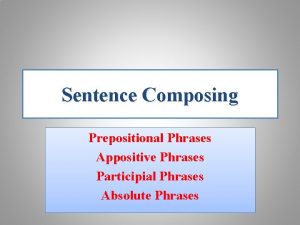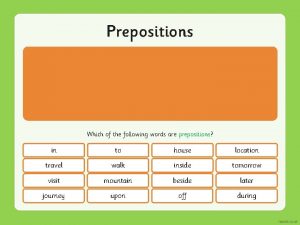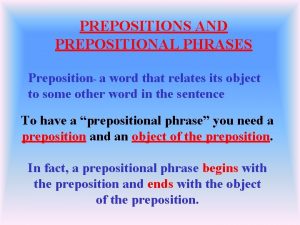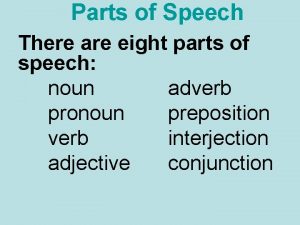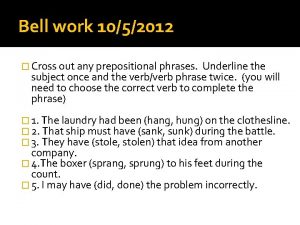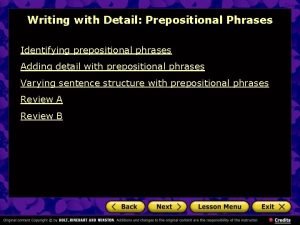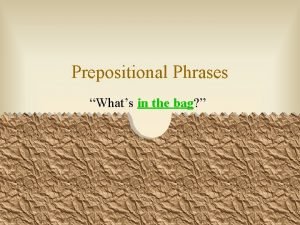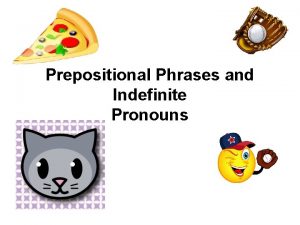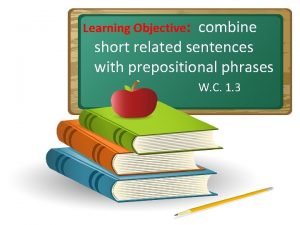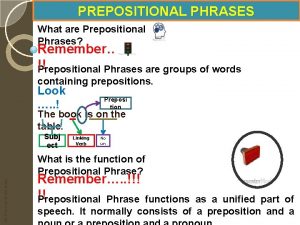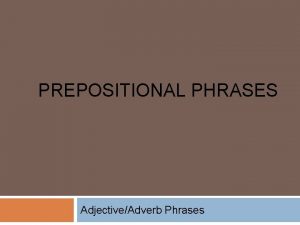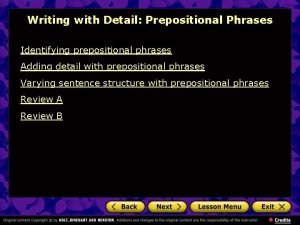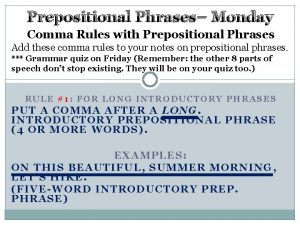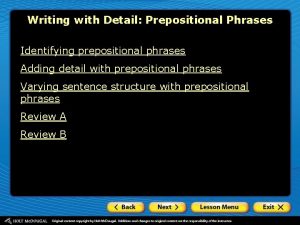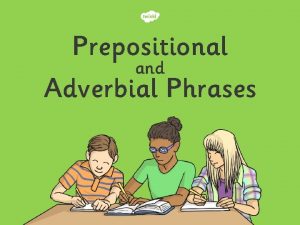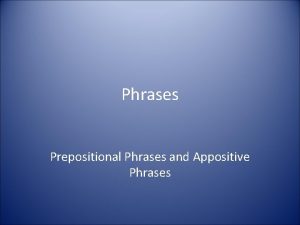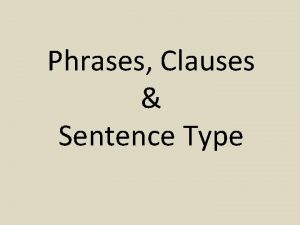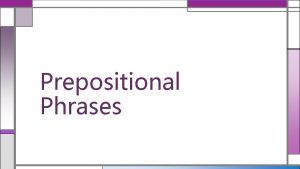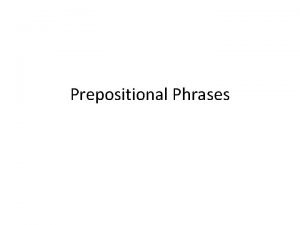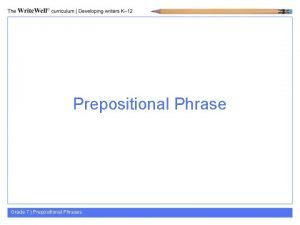2015 07 13 Introduction Prepositional phrases PPs express


















- Slides: 18

张昊 2015. 07. 13

Introduction • Prepositional phrases (PPs) express crucial information that IE methods need to extract • PPs are a major source of syntactic ambiguity • In this paper, semantic knowledge is used to improve PP attachment disambiguation • The PP attachment problem • given a PP occurring within a sentence where there are multiple possible attachment sites for the PP, choose the most plausible attachment site

Introduction • S 1. ) Alice caught the butterfly with the spots. • S 2. ) Alice caught the butterfly with the net.

Introduction • 4 -word sequence: {v; n 1; p; n 2} (e. g. , {caught, butterfly, with, spots}) causes most PP ambiguities • The task is to determine if the prepositional phrase (p; n 2) attaches to the verb v or to the first noun n 1 • Approach • make extensive use of semantic knowledge about nouns, verbs, prepositions, pairs of nouns, and the discourse context in which a PP quad occurs. • in training the model, rely on both labeled and unlabeled data, employing an expectation maximization (EM) algorithm

Contributions • Semantic Knowledge • Previous methods largely rely on corpus statistics. Approach in this paper draws upon diverse sources of background knowledge, leading to performance improvements • Unlabeled Data • In addition to training on labeled data, also make use of a large amount of unlabeled data. This enhances the method’s ability to generalize to diverse data sets • Datasets • In addition to the standard Wall Street Journal corpus (WSJ), they labeled two new datasets for testing purposes, one from Wikipedia (WKP), and another from the New York Times Corpus (NYTC)

State of the Art • Analyze performance of the widely used Stanford parser as of 2014, and the established baseline algorithm (Collins and Brooks, 1995), which has stood the test of time • Manually labeled PP quads from the NYTC dataset, prepended the noun phrase appearing before the quad, creating sentences made up of 5 lexical items (n 0 v n 1 p n 2) and applied the Stanford parser

State of the Art • The Collins baseline achieves 84% accuracy on the benchmark Wall Street Journal PP dataset. • Remove the trivial preposition, “of”, whose PPs are by default attached to the noun by this baseline, precision drops to 78%. • This analysis suggests there is substantial room for improvement.

Related Work • Statistics-based Methods • collect statistics on how often a given quadruple, {v, n 1, p, n 2}, occurs in the training data as a verb attachment as opposed to a noun attachment • the issue is sparsity, many quadruples occurring in the test data might not have been seen in the training data • Structure-based Methods • based on high-level observations that are then generalized into heuristics for PP attachment decisions • while simple, in practice these methods have been found to perform poorly

Related Work • Rule-based Methods • learn a set of transformation rules from a corpus • rules can be too specific to have broad applicability, resulting in low recall • Parser Correction Methods • given a dependency parse of a sentence, with potentially incorrect PP attachments, rectify it such that the prepositional phrases attach to the correct sites • these methods do not take semantic knowledge into account. • Sense Disambiguation • even a syntactically correctly attached PP can still be semantically ambiguous • when extracting information from prepositions, the problem of preposition sense disambiguation (semantics) has to be addressed in addition to prepositional phrase attachment disambiguation (syntax). • In this paper, their focus is on the latter.

Methodology • Generating features from background knowledge • Training a model to learn with these features

Methodology • The choice of features was motivated by empirically driven characterization of the problem as follows: • For verb-attaching PPs, n 2 is usually a role filler for the verb • The net fills the role of an instrument for the verb catch • For noun-attaching PPs, one noun describes or elaborates on the other • the second noun n 2 describes the first noun n 1 • n 2 might be an attribute or property of n 1, as in the spots(n 2) are an attribute of the butterfly (n 1) • the first noun n 1 describes the second noun n 2 • {expect, decline, in, rates}, where the PP “in rates”, attaches to the noun. The decline: n 1 that is expected: v is in the rates: n 2

Methodology

Methodology • Compute P(y|x) • the probability that the PP (p, n 2) in the tuple {v, n 1, p, n 2} attaches to the verb (v) , y = 1 or to the noun(n 1), y = 0 • given a feature vector x describing that tuple • Input to training the model • a collection of PP quads, D where • a small subset, is labeled data, thus for each we know the corresponding • the rest of the quads, are unlabeled, hence their corresponding are unknown. • from each PP quad , extract a feature vector according to the feature generation process • Model • discriminative model performed better • use the logistic function: • Parameter Estimation • is a vector of model parameters • use an Expectation Maximization (EM) algorithm to estimate model parameters

Experimental Evaluation

Experimental Evaluation

Experimental Evaluation

Conclusion • Presented a knowledge-intensive approach to prepositional phrase (PP) attachment disambiguation, which is a type of syntactic ambiguity • Trained a model using labeled data and unlabeled data, making use of expectation maximization for parameter estimation • Used background knowledge from existing resources to read better in order to further populate knowledge bases with otherwise difficult to extract knowledge • Future work • read details about the where, why, who of events and relations, effectively moving from extracting only binary relations to reading at a more general level

Thank you!
 The main person animal or object in a story
The main person animal or object in a story Subject verb agreement examples
Subject verb agreement examples Subject verb agreement uncountable nouns
Subject verb agreement uncountable nouns Subject-verb agreement rules
Subject-verb agreement rules Prepositional phrase opener
Prepositional phrase opener Is when a preposition word
Is when a preposition word Prepositionsl phrase
Prepositionsl phrase Simple subject
Simple subject Preposition
Preposition Combining sentences with prepositional phrases
Combining sentences with prepositional phrases Appositive prepositional phrase
Appositive prepositional phrase Cross out any prepositional phrases
Cross out any prepositional phrases Identifying prepositional phrases
Identifying prepositional phrases Prepositional phrases songs
Prepositional phrases songs Function of preposition
Function of preposition Whats a prepositional phrases
Whats a prepositional phrases Indefinite preposition
Indefinite preposition Combining sentences with prepositional phrases
Combining sentences with prepositional phrases Infinite phrase
Infinite phrase




